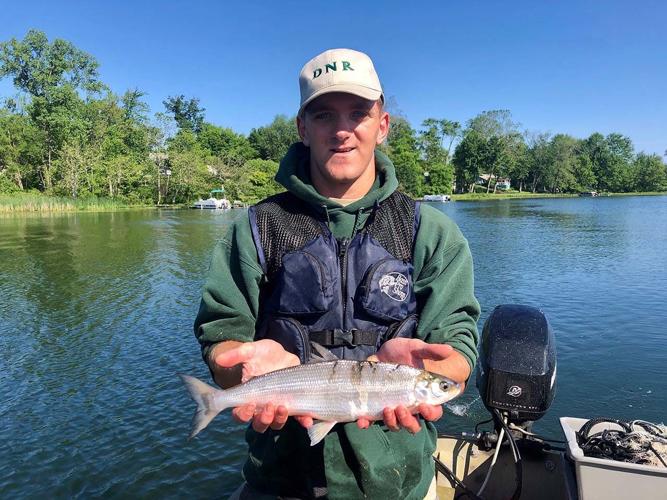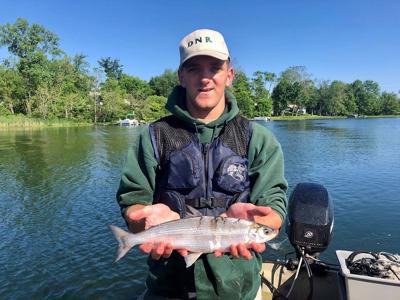As of today, it is illegal to take state-endangered cisco from Indiana lakes.
The Indiana Department of Natural Resources announced the new fishing prohibition based on the Indiana Natural Resources Commission changing the status of the fish from a species of special concern to endangered this fall.
Cisco only remain in seven lakes in northeastern Indiana. In 1955, the species could be found in 42 northern Indiana lakes, including the Lake James chain in Steuben County.
It is the only native fish from the salmon family in Indiana waters other than Lake Michigan. It is a cold-water species that requires exceptional water quality to thrive. The glacial lakes of northern Indiana represent the southernmost extent of the species’ range in North America.
Two Steuben County lakes, Lake Gage and Failing Lake; three lakes in LaGrange County, North and South Twin lakes and Eve Lake; and Noble County’s Crooked Lake are among the last clean, cold habitats available for the fish in Indiana, said a news release from the DNR.
“The best way to preserve the water quality of Indiana’s cisco lakes is to implement best-management practices that reduce the quantity of nutrients and sediment entering the water,” said Matthew Linn, IDNR fisheries research biologist. “The preservation of water quality at these lakes is vital because once degraded, water quality is costly and difficult to restore.”
The lakes that support cisco hold “cold, clear, oxygen-rich water,” said Linn.
Attempts to reintroduce cisco at Gilbert Lake in Noble County in 1979 and Green Lake in Steuben County in the early 1990s failed, says a report by the DNR’s Division of Fish and Wildlife.
Future cisco management will focus on collaborative efforts with regional partners to preserve cold-water habitat through the application of best-management practices that reduce the quantity of nutrients entering the remaining lakes with cisco, said the news release.
“The extirpation of cisco from many northern Indiana lakes is primarily attributed to soil erosion, nutrient enrichment, shoreline alterations and warming water temperatures,” said Linn.
Nutrients include phosphorus and nitrogen, which are found naturally in the environment and support the growth of aquatic plants. They become a problem when human-created excesses of nitrogen and phosphorus wash into the water. Excess nitrogen and phosphorus come from animal manure, chemical fertilizers, municipal pollution, sewage, industrial waste, soaps and detergents, says the U.S. Environmental Protection Agency.
Too much nitrogen and phosphorus in the water causes algae to grow faster than ecosystems can handle. Significant increases in algae harm water quality and the food resources and habitats fish and other aquatic life need to survive. The algae also decrease oxygen, another vital element for survival.
Soil erosion can be caused by removal of native plants and trees that formerly held it in place or changes to landscape from development activities. Shoreline alterations could include attempts to create recreational opportunities, such as swimming areas or sea walls, where a more natural habitat once existed.
Water temperature governs the kinds of organisms that live in water bodies, says the United States Geological Survey.
Human development can cause a spike in water temperatures when there is runoff from impervious surfaces, says the USGS. A concrete driveway is an example of an impervious surface. If a heavy rain falls on lakeside concrete before the sun comes out, the water on the concrete will heat quickly then could wash into the lake, abruptly changing the water temperature.
Changes in temperature that cause warm water to linger until ice covers a lake can cause the water to “turn,” says the USGS, affecting the temperature in the lower parts of the lake where water typically would remain very cold at all times. This, in turn, could have a negative affect on living beings adapted to that ecosystem.
In a September 2018 report based on the Indiana Climate Change Impacts Assessment, Purdue University researchers evaluated the impact of global warming on native aquatic species.
“As air temperatures warm 5 to 6 degrees by mid-century, water temperatures in Indiana’s streams, rivers and lakes will increase, the duration and extent of ice cover will decline, and lake stratification during the warm season will last longer,” says a synopsis of the report. “Shifting thermal characteristics in Indiana’s water bodies will have rippling effects on aquatic organisms, including their growth, survival and reproduction patterns. Warming water temperatures will generally maintain or increase habitat range for Indiana’s warm water fishes, while significantly reducing habitat for Indiana’s cool water and cold water fishes.”
Preserving the cold-water cisco amid environmental changes and human encroachment will be a challenge. The NRC took a first step by protecting them as an endangered species. Best-management practices that follow could potentially require lake property owners to assess their activities in light of the natural resources they chose to live along.





































































(0) comments
Welcome to the discussion.
Log In
Keep it Clean. Please avoid obscene, vulgar, lewd, racist or sexually-oriented language.
PLEASE TURN OFF YOUR CAPS LOCK.
Don't Threaten. Threats of harming another person will not be tolerated.
Be Truthful. Don't knowingly lie about anyone or anything.
Be Nice. No racism, sexism or any sort of -ism that is degrading to another person.
Be Proactive. Use the 'Report' link on each comment to let us know of abusive posts.
Share with Us. We'd love to hear eyewitness accounts, the history behind an article.